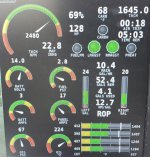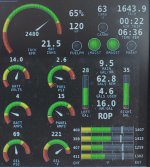
Hi, I was thinking of replacing my MP gauge with a fuel flow/ carb temp gauge in my fixed pitch O 320 RV.Is there any sound reason why I shouldn’t do this ? My plan is to lean to fuel flow( I do still have EGT to monitor). Any thoughts appreciated.Cheers
Question for those of you with with fuel flow on a carb'd engine: How stable is the flow indication with a steady power setting? The one plane that I have flown in with this set up had the flow rate hunting the entire flight.
Question for those of you with with fuel flow on a carb'd engine: How stable is the flow indication with a steady power setting? The one plane that I have flown in with this set up had the flow rate hunting the entire flight.
When I had my old RV-4 with a fixed pitch prop, back in the days when fuel flow gauges were rare, MP was invaluable. I could change power setting by 3" with no change in RPM.
These days, in the RV-9A with the Garmin G3X Touch, I set 2200 RPM, EGT just below 1400° and set the throttle to read out 8 GPH directly. Greatly simplifies fuel management when fuel flow is always at 8 GPH.
My instinctive response to the question was MP, of course, because the real reason for knowing power settings was to estimate fuel flow. But since you can read fuel flow directly... who needs MP?
Hi, I was thinking of replacing my MP gauge with a fuel flow/ carb temp gauge in my fixed pitch O 320 RV.Is there any sound reason why I shouldn’t do this ? My plan is to lean to fuel flow( I do still have EGT to monitor). Any thoughts appreciated.Cheers
I can see I should learn more about the MP gage and what info it provides that my FF and % power dont give me. Thanks for the nudge.So there you have it.
Some that say it is useless and some that say they use it almost exclusively over looking at the tach.
For those that find their way to this thread in the future…. Consider carefully the explanations they give for having a MP gauge. Once you understand them, you may find it valuable as well.
MP doesn't give you any needed information that you can't get elsewhere. It's just that RPM, FF, and % pwr all take a few seconds to stabilize whereas MP indication is immediate.I can see I should learn more about the MP gage and what info it provides that my FF and % power dont give me. Thanks for the nudge.
Thanks Mel. That helps.MP doesn't give you any needed information that you can't get elsewhere. It's just that RPM, FF, and % pwr all take a few seconds to stabilize whereas MP indication is immediate.

